The Extent of Organisational Responsibility for Workplace Equality
VerifiedAdded on 2022/11/18
|8
|2255
|336
Essay
AI Summary
This essay delves into the extent to which organisations are responsible for ensuring equality in the workplace. It explores the multifaceted nature of workplace equality, addressing issues such as performance appraisals, socio-cultural factors, affirmative action, and the development of organisational capabilities to promote diversity. The essay examines the impact of globalization on workforce demographics and the need for inclusive policies. It differentiates between equal opportunities and diversity management, highlighting best practices like identifying and preventing unconscious bias. The analysis covers the legal framework in the UK, referencing relevant acts and legislation. Furthermore, the essay underscores the benefits of a diverse workforce, including enhanced productivity, improved employee morale, and a broader talent pool. The challenges of implementing diversity initiatives, such as communication barriers, are also considered, alongside the role of affirmative action. The essay draws on a range of academic sources to support its arguments, providing a comprehensive overview of the topic.
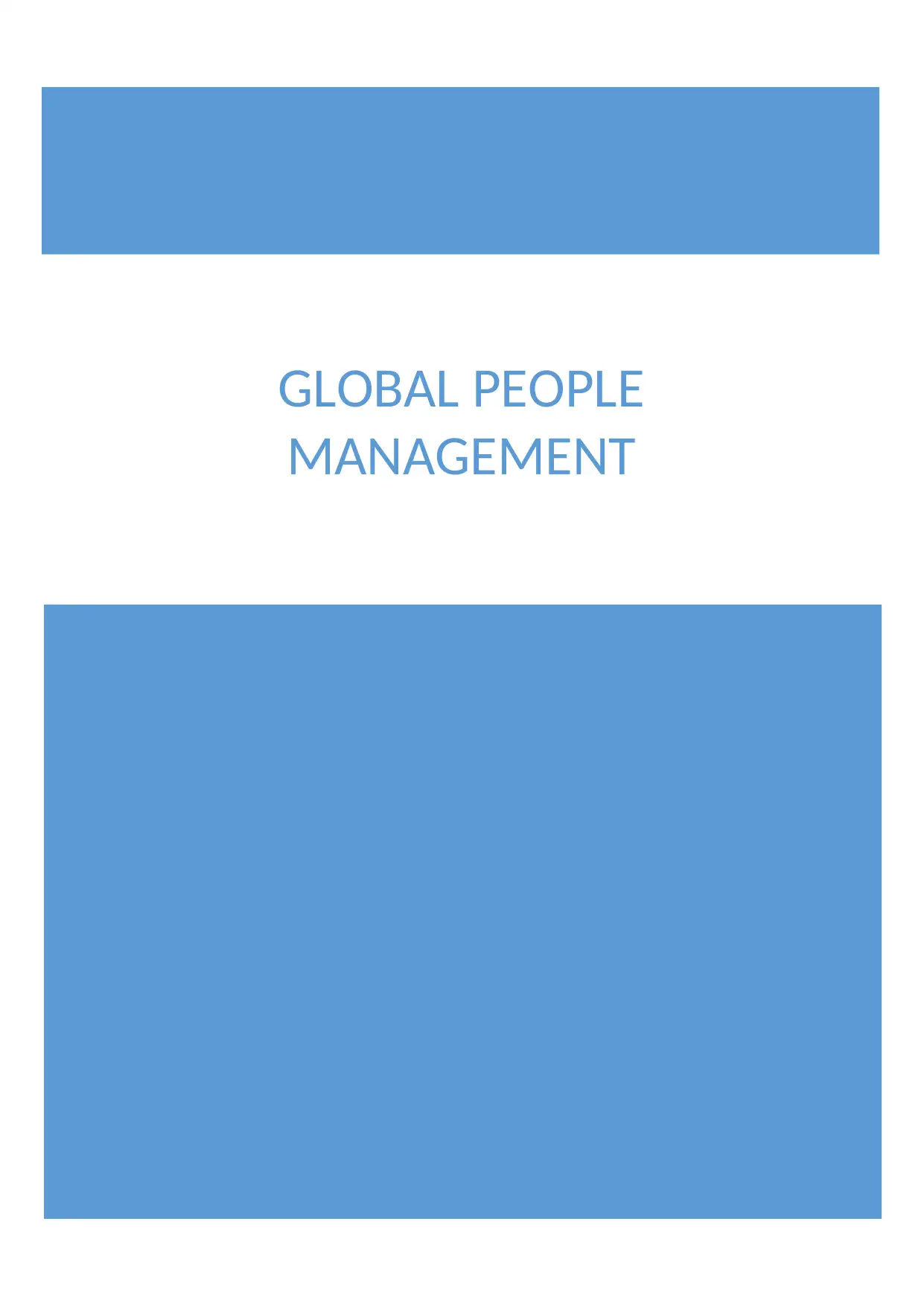
GLOBAL PEOPLE
MANAGEMENT
MANAGEMENT
Paraphrase This Document
Need a fresh take? Get an instant paraphrase of this document with our AI Paraphraser
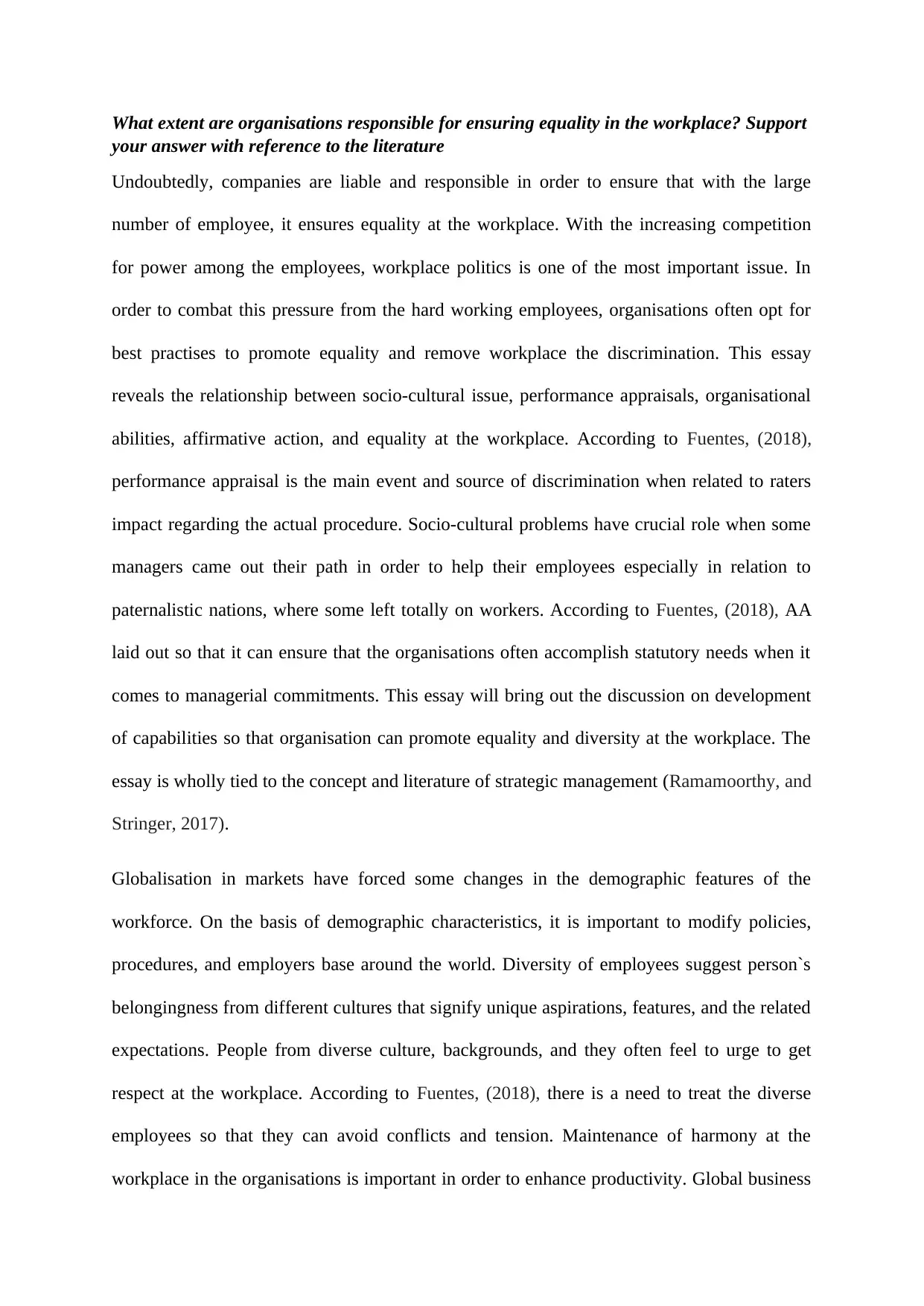
What extent are organisations responsible for ensuring equality in the workplace? Support
your answer with reference to the literature
Undoubtedly, companies are liable and responsible in order to ensure that with the large
number of employee, it ensures equality at the workplace. With the increasing competition
for power among the employees, workplace politics is one of the most important issue. In
order to combat this pressure from the hard working employees, organisations often opt for
best practises to promote equality and remove workplace the discrimination. This essay
reveals the relationship between socio-cultural issue, performance appraisals, organisational
abilities, affirmative action, and equality at the workplace. According to Fuentes, (2018),
performance appraisal is the main event and source of discrimination when related to raters
impact regarding the actual procedure. Socio-cultural problems have crucial role when some
managers came out their path in order to help their employees especially in relation to
paternalistic nations, where some left totally on workers. According to Fuentes, (2018), AA
laid out so that it can ensure that the organisations often accomplish statutory needs when it
comes to managerial commitments. This essay will bring out the discussion on development
of capabilities so that organisation can promote equality and diversity at the workplace. The
essay is wholly tied to the concept and literature of strategic management (Ramamoorthy, and
Stringer, 2017).
Globalisation in markets have forced some changes in the demographic features of the
workforce. On the basis of demographic characteristics, it is important to modify policies,
procedures, and employers base around the world. Diversity of employees suggest person`s
belongingness from different cultures that signify unique aspirations, features, and the related
expectations. People from diverse culture, backgrounds, and they often feel to urge to get
respect at the workplace. According to Fuentes, (2018), there is a need to treat the diverse
employees so that they can avoid conflicts and tension. Maintenance of harmony at the
workplace in the organisations is important in order to enhance productivity. Global business
your answer with reference to the literature
Undoubtedly, companies are liable and responsible in order to ensure that with the large
number of employee, it ensures equality at the workplace. With the increasing competition
for power among the employees, workplace politics is one of the most important issue. In
order to combat this pressure from the hard working employees, organisations often opt for
best practises to promote equality and remove workplace the discrimination. This essay
reveals the relationship between socio-cultural issue, performance appraisals, organisational
abilities, affirmative action, and equality at the workplace. According to Fuentes, (2018),
performance appraisal is the main event and source of discrimination when related to raters
impact regarding the actual procedure. Socio-cultural problems have crucial role when some
managers came out their path in order to help their employees especially in relation to
paternalistic nations, where some left totally on workers. According to Fuentes, (2018), AA
laid out so that it can ensure that the organisations often accomplish statutory needs when it
comes to managerial commitments. This essay will bring out the discussion on development
of capabilities so that organisation can promote equality and diversity at the workplace. The
essay is wholly tied to the concept and literature of strategic management (Ramamoorthy, and
Stringer, 2017).
Globalisation in markets have forced some changes in the demographic features of the
workforce. On the basis of demographic characteristics, it is important to modify policies,
procedures, and employers base around the world. Diversity of employees suggest person`s
belongingness from different cultures that signify unique aspirations, features, and the related
expectations. People from diverse culture, backgrounds, and they often feel to urge to get
respect at the workplace. According to Fuentes, (2018), there is a need to treat the diverse
employees so that they can avoid conflicts and tension. Maintenance of harmony at the
workplace in the organisations is important in order to enhance productivity. Global business
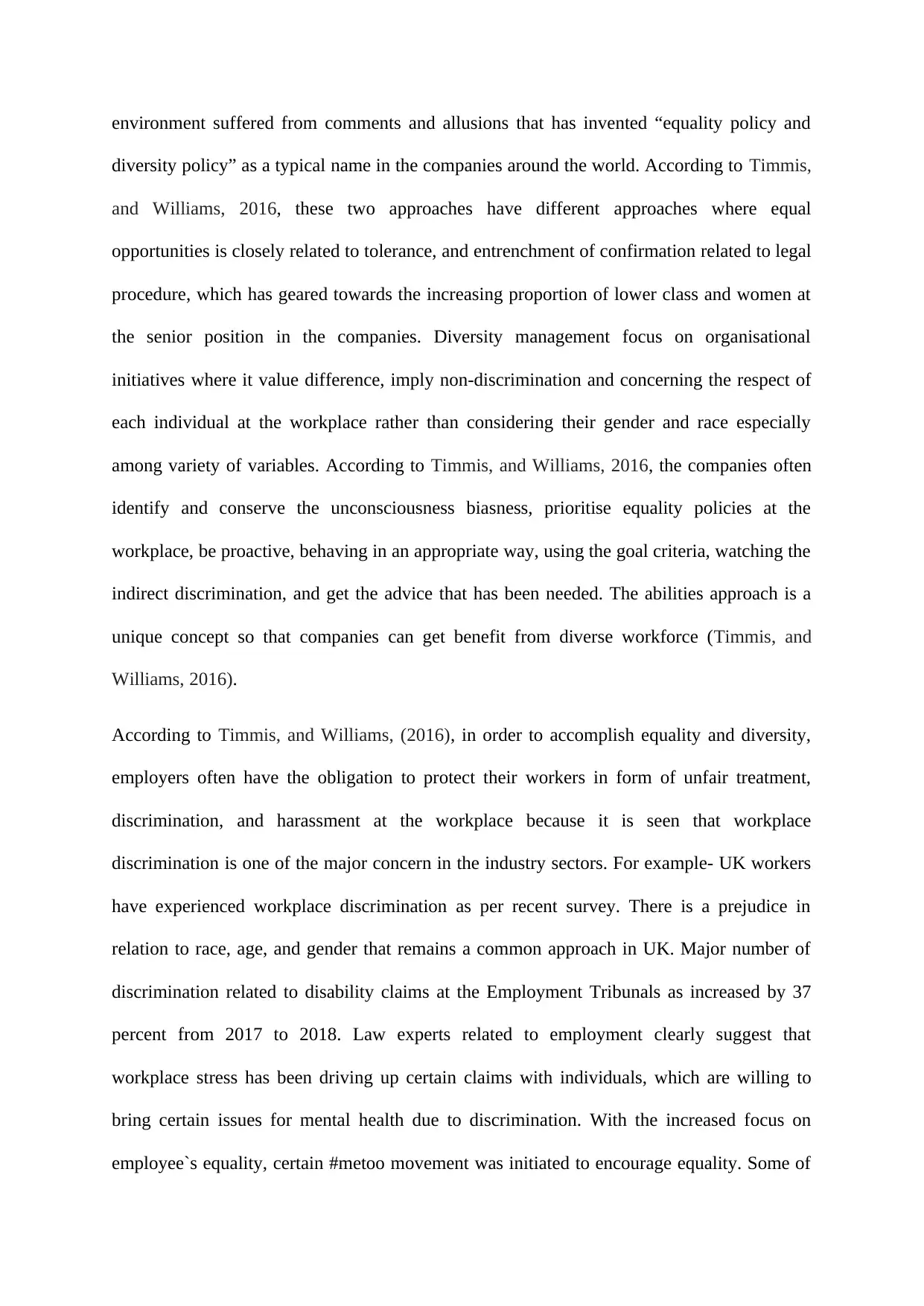
environment suffered from comments and allusions that has invented “equality policy and
diversity policy” as a typical name in the companies around the world. According to Timmis,
and Williams, 2016, these two approaches have different approaches where equal
opportunities is closely related to tolerance, and entrenchment of confirmation related to legal
procedure, which has geared towards the increasing proportion of lower class and women at
the senior position in the companies. Diversity management focus on organisational
initiatives where it value difference, imply non-discrimination and concerning the respect of
each individual at the workplace rather than considering their gender and race especially
among variety of variables. According to Timmis, and Williams, 2016, the companies often
identify and conserve the unconsciousness biasness, prioritise equality policies at the
workplace, be proactive, behaving in an appropriate way, using the goal criteria, watching the
indirect discrimination, and get the advice that has been needed. The abilities approach is a
unique concept so that companies can get benefit from diverse workforce (Timmis, and
Williams, 2016).
According to Timmis, and Williams, (2016), in order to accomplish equality and diversity,
employers often have the obligation to protect their workers in form of unfair treatment,
discrimination, and harassment at the workplace because it is seen that workplace
discrimination is one of the major concern in the industry sectors. For example- UK workers
have experienced workplace discrimination as per recent survey. There is a prejudice in
relation to race, age, and gender that remains a common approach in UK. Major number of
discrimination related to disability claims at the Employment Tribunals as increased by 37
percent from 2017 to 2018. Law experts related to employment clearly suggest that
workplace stress has been driving up certain claims with individuals, which are willing to
bring certain issues for mental health due to discrimination. With the increased focus on
employee`s equality, certain #metoo movement was initiated to encourage equality. Some of
diversity policy” as a typical name in the companies around the world. According to Timmis,
and Williams, 2016, these two approaches have different approaches where equal
opportunities is closely related to tolerance, and entrenchment of confirmation related to legal
procedure, which has geared towards the increasing proportion of lower class and women at
the senior position in the companies. Diversity management focus on organisational
initiatives where it value difference, imply non-discrimination and concerning the respect of
each individual at the workplace rather than considering their gender and race especially
among variety of variables. According to Timmis, and Williams, 2016, the companies often
identify and conserve the unconsciousness biasness, prioritise equality policies at the
workplace, be proactive, behaving in an appropriate way, using the goal criteria, watching the
indirect discrimination, and get the advice that has been needed. The abilities approach is a
unique concept so that companies can get benefit from diverse workforce (Timmis, and
Williams, 2016).
According to Timmis, and Williams, (2016), in order to accomplish equality and diversity,
employers often have the obligation to protect their workers in form of unfair treatment,
discrimination, and harassment at the workplace because it is seen that workplace
discrimination is one of the major concern in the industry sectors. For example- UK workers
have experienced workplace discrimination as per recent survey. There is a prejudice in
relation to race, age, and gender that remains a common approach in UK. Major number of
discrimination related to disability claims at the Employment Tribunals as increased by 37
percent from 2017 to 2018. Law experts related to employment clearly suggest that
workplace stress has been driving up certain claims with individuals, which are willing to
bring certain issues for mental health due to discrimination. With the increased focus on
employee`s equality, certain #metoo movement was initiated to encourage equality. Some of
⊘ This is a preview!⊘
Do you want full access?
Subscribe today to unlock all pages.

Trusted by 1+ million students worldwide
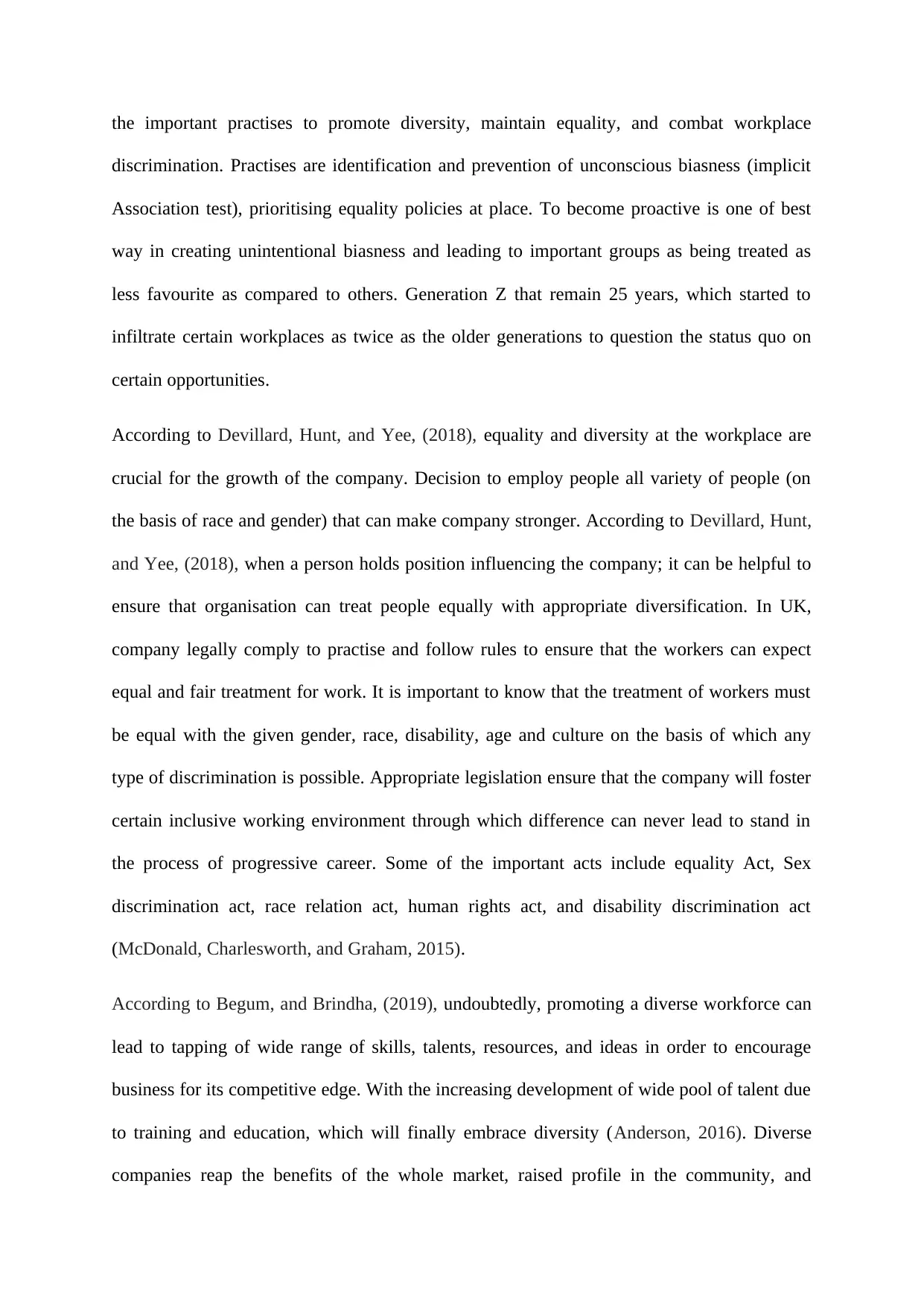
the important practises to promote diversity, maintain equality, and combat workplace
discrimination. Practises are identification and prevention of unconscious biasness (implicit
Association test), prioritising equality policies at place. To become proactive is one of best
way in creating unintentional biasness and leading to important groups as being treated as
less favourite as compared to others. Generation Z that remain 25 years, which started to
infiltrate certain workplaces as twice as the older generations to question the status quo on
certain opportunities.
According to Devillard, Hunt, and Yee, (2018), equality and diversity at the workplace are
crucial for the growth of the company. Decision to employ people all variety of people (on
the basis of race and gender) that can make company stronger. According to Devillard, Hunt,
and Yee, (2018), when a person holds position influencing the company; it can be helpful to
ensure that organisation can treat people equally with appropriate diversification. In UK,
company legally comply to practise and follow rules to ensure that the workers can expect
equal and fair treatment for work. It is important to know that the treatment of workers must
be equal with the given gender, race, disability, age and culture on the basis of which any
type of discrimination is possible. Appropriate legislation ensure that the company will foster
certain inclusive working environment through which difference can never lead to stand in
the process of progressive career. Some of the important acts include equality Act, Sex
discrimination act, race relation act, human rights act, and disability discrimination act
(McDonald, Charlesworth, and Graham, 2015).
According to Begum, and Brindha, (2019), undoubtedly, promoting a diverse workforce can
lead to tapping of wide range of skills, talents, resources, and ideas in order to encourage
business for its competitive edge. With the increasing development of wide pool of talent due
to training and education, which will finally embrace diversity (Anderson, 2016). Diverse
companies reap the benefits of the whole market, raised profile in the community, and
discrimination. Practises are identification and prevention of unconscious biasness (implicit
Association test), prioritising equality policies at place. To become proactive is one of best
way in creating unintentional biasness and leading to important groups as being treated as
less favourite as compared to others. Generation Z that remain 25 years, which started to
infiltrate certain workplaces as twice as the older generations to question the status quo on
certain opportunities.
According to Devillard, Hunt, and Yee, (2018), equality and diversity at the workplace are
crucial for the growth of the company. Decision to employ people all variety of people (on
the basis of race and gender) that can make company stronger. According to Devillard, Hunt,
and Yee, (2018), when a person holds position influencing the company; it can be helpful to
ensure that organisation can treat people equally with appropriate diversification. In UK,
company legally comply to practise and follow rules to ensure that the workers can expect
equal and fair treatment for work. It is important to know that the treatment of workers must
be equal with the given gender, race, disability, age and culture on the basis of which any
type of discrimination is possible. Appropriate legislation ensure that the company will foster
certain inclusive working environment through which difference can never lead to stand in
the process of progressive career. Some of the important acts include equality Act, Sex
discrimination act, race relation act, human rights act, and disability discrimination act
(McDonald, Charlesworth, and Graham, 2015).
According to Begum, and Brindha, (2019), undoubtedly, promoting a diverse workforce can
lead to tapping of wide range of skills, talents, resources, and ideas in order to encourage
business for its competitive edge. With the increasing development of wide pool of talent due
to training and education, which will finally embrace diversity (Anderson, 2016). Diverse
companies reap the benefits of the whole market, raised profile in the community, and
Paraphrase This Document
Need a fresh take? Get an instant paraphrase of this document with our AI Paraphraser
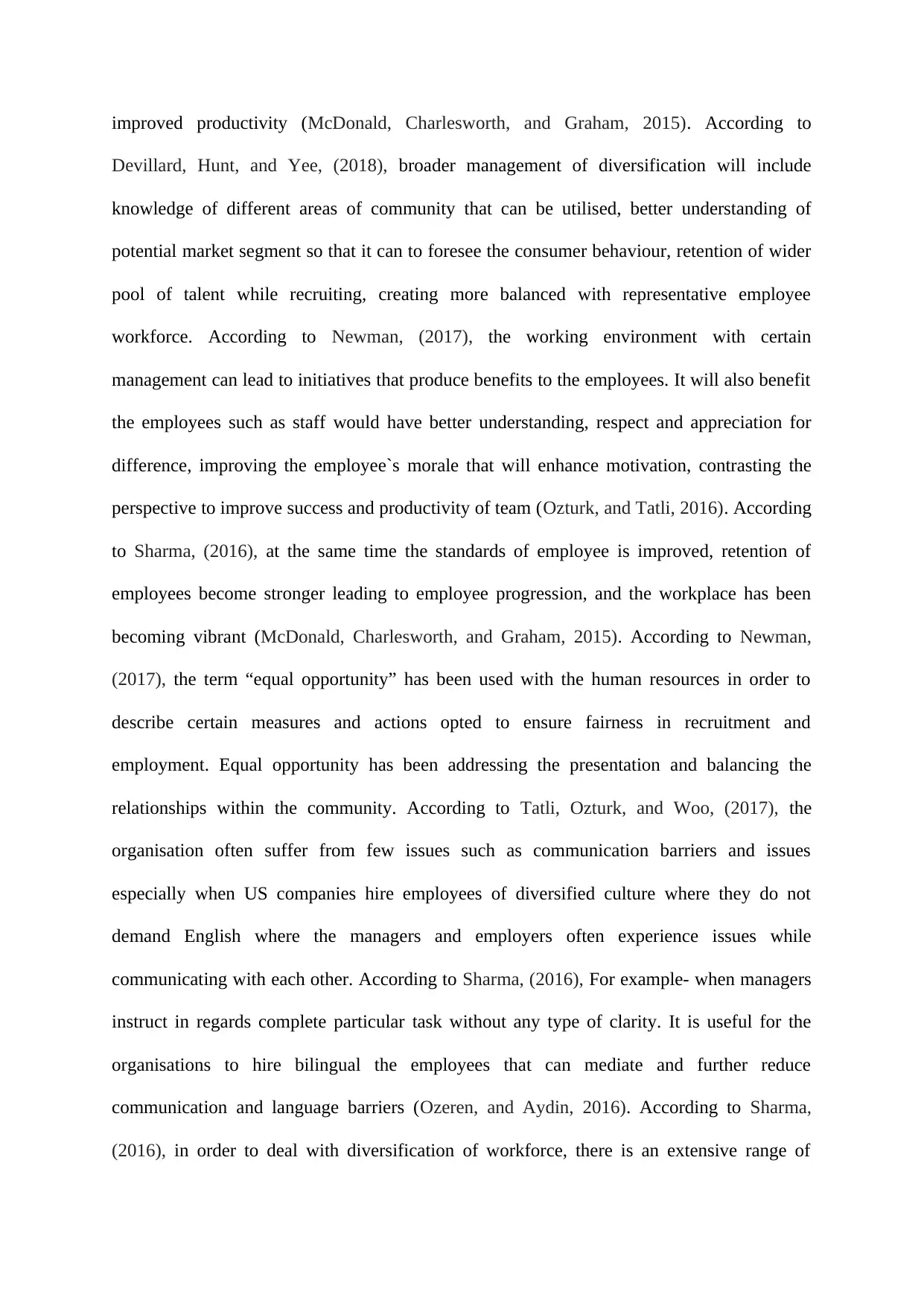
improved productivity (McDonald, Charlesworth, and Graham, 2015). According to
Devillard, Hunt, and Yee, (2018), broader management of diversification will include
knowledge of different areas of community that can be utilised, better understanding of
potential market segment so that it can to foresee the consumer behaviour, retention of wider
pool of talent while recruiting, creating more balanced with representative employee
workforce. According to Newman, (2017), the working environment with certain
management can lead to initiatives that produce benefits to the employees. It will also benefit
the employees such as staff would have better understanding, respect and appreciation for
difference, improving the employee`s morale that will enhance motivation, contrasting the
perspective to improve success and productivity of team (Ozturk, and Tatli, 2016). According
to Sharma, (2016), at the same time the standards of employee is improved, retention of
employees become stronger leading to employee progression, and the workplace has been
becoming vibrant (McDonald, Charlesworth, and Graham, 2015). According to Newman,
(2017), the term “equal opportunity” has been used with the human resources in order to
describe certain measures and actions opted to ensure fairness in recruitment and
employment. Equal opportunity has been addressing the presentation and balancing the
relationships within the community. According to Tatli, Ozturk, and Woo, (2017), the
organisation often suffer from few issues such as communication barriers and issues
especially when US companies hire employees of diversified culture where they do not
demand English where the managers and employers often experience issues while
communicating with each other. According to Sharma, (2016), For example- when managers
instruct in regards complete particular task without any type of clarity. It is useful for the
organisations to hire bilingual the employees that can mediate and further reduce
communication and language barriers (Ozeren, and Aydin, 2016). According to Sharma,
(2016), in order to deal with diversification of workforce, there is an extensive range of
Devillard, Hunt, and Yee, (2018), broader management of diversification will include
knowledge of different areas of community that can be utilised, better understanding of
potential market segment so that it can to foresee the consumer behaviour, retention of wider
pool of talent while recruiting, creating more balanced with representative employee
workforce. According to Newman, (2017), the working environment with certain
management can lead to initiatives that produce benefits to the employees. It will also benefit
the employees such as staff would have better understanding, respect and appreciation for
difference, improving the employee`s morale that will enhance motivation, contrasting the
perspective to improve success and productivity of team (Ozturk, and Tatli, 2016). According
to Sharma, (2016), at the same time the standards of employee is improved, retention of
employees become stronger leading to employee progression, and the workplace has been
becoming vibrant (McDonald, Charlesworth, and Graham, 2015). According to Newman,
(2017), the term “equal opportunity” has been used with the human resources in order to
describe certain measures and actions opted to ensure fairness in recruitment and
employment. Equal opportunity has been addressing the presentation and balancing the
relationships within the community. According to Tatli, Ozturk, and Woo, (2017), the
organisation often suffer from few issues such as communication barriers and issues
especially when US companies hire employees of diversified culture where they do not
demand English where the managers and employers often experience issues while
communicating with each other. According to Sharma, (2016), For example- when managers
instruct in regards complete particular task without any type of clarity. It is useful for the
organisations to hire bilingual the employees that can mediate and further reduce
communication and language barriers (Ozeren, and Aydin, 2016). According to Sharma,
(2016), in order to deal with diversification of workforce, there is an extensive range of
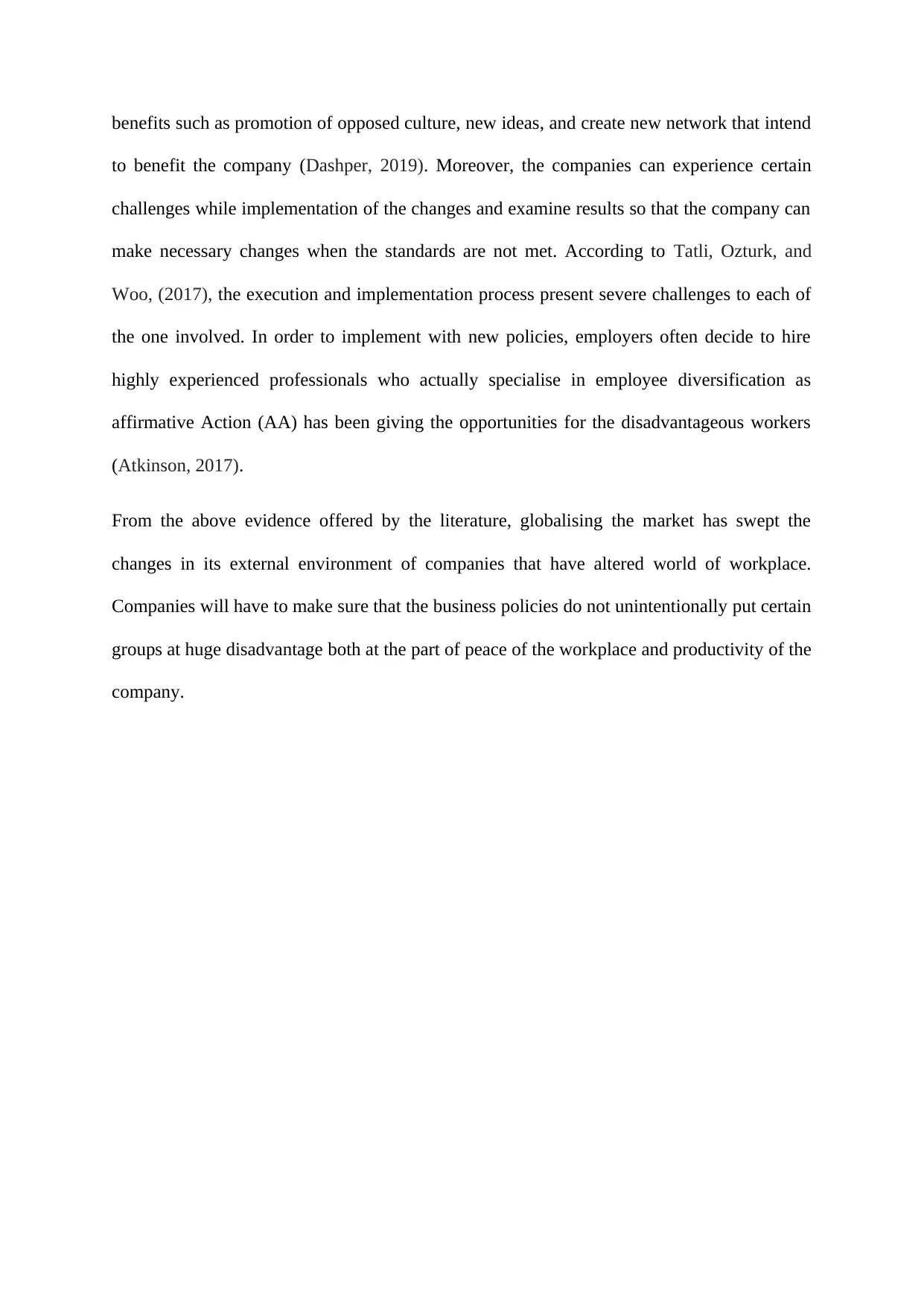
benefits such as promotion of opposed culture, new ideas, and create new network that intend
to benefit the company (Dashper, 2019). Moreover, the companies can experience certain
challenges while implementation of the changes and examine results so that the company can
make necessary changes when the standards are not met. According to Tatli, Ozturk, and
Woo, (2017), the execution and implementation process present severe challenges to each of
the one involved. In order to implement with new policies, employers often decide to hire
highly experienced professionals who actually specialise in employee diversification as
affirmative Action (AA) has been giving the opportunities for the disadvantageous workers
(Atkinson, 2017).
From the above evidence offered by the literature, globalising the market has swept the
changes in its external environment of companies that have altered world of workplace.
Companies will have to make sure that the business policies do not unintentionally put certain
groups at huge disadvantage both at the part of peace of the workplace and productivity of the
company.
to benefit the company (Dashper, 2019). Moreover, the companies can experience certain
challenges while implementation of the changes and examine results so that the company can
make necessary changes when the standards are not met. According to Tatli, Ozturk, and
Woo, (2017), the execution and implementation process present severe challenges to each of
the one involved. In order to implement with new policies, employers often decide to hire
highly experienced professionals who actually specialise in employee diversification as
affirmative Action (AA) has been giving the opportunities for the disadvantageous workers
(Atkinson, 2017).
From the above evidence offered by the literature, globalising the market has swept the
changes in its external environment of companies that have altered world of workplace.
Companies will have to make sure that the business policies do not unintentionally put certain
groups at huge disadvantage both at the part of peace of the workplace and productivity of the
company.
⊘ This is a preview!⊘
Do you want full access?
Subscribe today to unlock all pages.

Trusted by 1+ million students worldwide
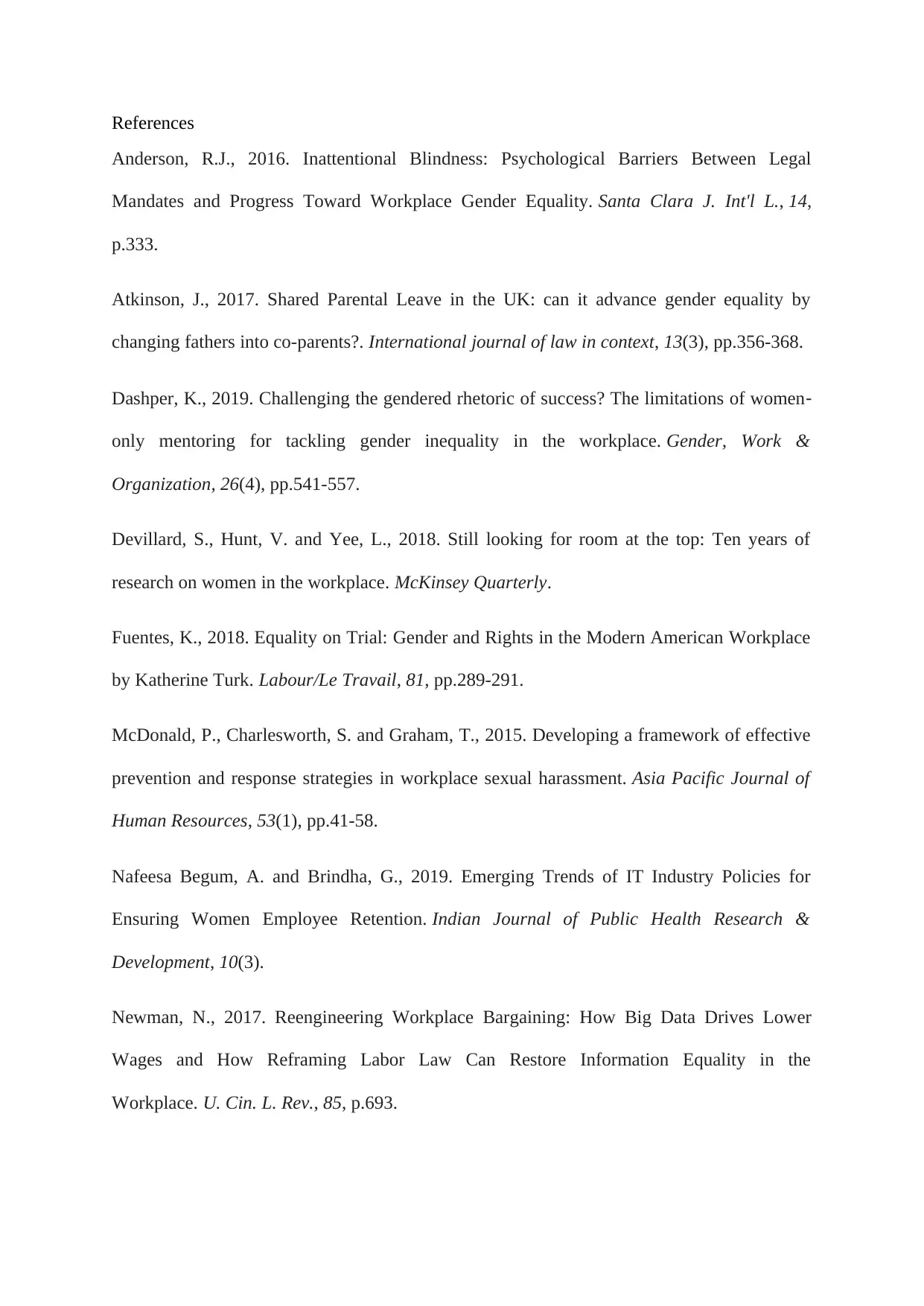
References
Anderson, R.J., 2016. Inattentional Blindness: Psychological Barriers Between Legal
Mandates and Progress Toward Workplace Gender Equality. Santa Clara J. Int'l L., 14,
p.333.
Atkinson, J., 2017. Shared Parental Leave in the UK: can it advance gender equality by
changing fathers into co-parents?. International journal of law in context, 13(3), pp.356-368.
Dashper, K., 2019. Challenging the gendered rhetoric of success? The limitations of women‐
only mentoring for tackling gender inequality in the workplace. Gender, Work &
Organization, 26(4), pp.541-557.
Devillard, S., Hunt, V. and Yee, L., 2018. Still looking for room at the top: Ten years of
research on women in the workplace. McKinsey Quarterly.
Fuentes, K., 2018. Equality on Trial: Gender and Rights in the Modern American Workplace
by Katherine Turk. Labour/Le Travail, 81, pp.289-291.
McDonald, P., Charlesworth, S. and Graham, T., 2015. Developing a framework of effective
prevention and response strategies in workplace sexual harassment. Asia Pacific Journal of
Human Resources, 53(1), pp.41-58.
Nafeesa Begum, A. and Brindha, G., 2019. Emerging Trends of IT Industry Policies for
Ensuring Women Employee Retention. Indian Journal of Public Health Research &
Development, 10(3).
Newman, N., 2017. Reengineering Workplace Bargaining: How Big Data Drives Lower
Wages and How Reframing Labor Law Can Restore Information Equality in the
Workplace. U. Cin. L. Rev., 85, p.693.
Anderson, R.J., 2016. Inattentional Blindness: Psychological Barriers Between Legal
Mandates and Progress Toward Workplace Gender Equality. Santa Clara J. Int'l L., 14,
p.333.
Atkinson, J., 2017. Shared Parental Leave in the UK: can it advance gender equality by
changing fathers into co-parents?. International journal of law in context, 13(3), pp.356-368.
Dashper, K., 2019. Challenging the gendered rhetoric of success? The limitations of women‐
only mentoring for tackling gender inequality in the workplace. Gender, Work &
Organization, 26(4), pp.541-557.
Devillard, S., Hunt, V. and Yee, L., 2018. Still looking for room at the top: Ten years of
research on women in the workplace. McKinsey Quarterly.
Fuentes, K., 2018. Equality on Trial: Gender and Rights in the Modern American Workplace
by Katherine Turk. Labour/Le Travail, 81, pp.289-291.
McDonald, P., Charlesworth, S. and Graham, T., 2015. Developing a framework of effective
prevention and response strategies in workplace sexual harassment. Asia Pacific Journal of
Human Resources, 53(1), pp.41-58.
Nafeesa Begum, A. and Brindha, G., 2019. Emerging Trends of IT Industry Policies for
Ensuring Women Employee Retention. Indian Journal of Public Health Research &
Development, 10(3).
Newman, N., 2017. Reengineering Workplace Bargaining: How Big Data Drives Lower
Wages and How Reframing Labor Law Can Restore Information Equality in the
Workplace. U. Cin. L. Rev., 85, p.693.
Paraphrase This Document
Need a fresh take? Get an instant paraphrase of this document with our AI Paraphraser
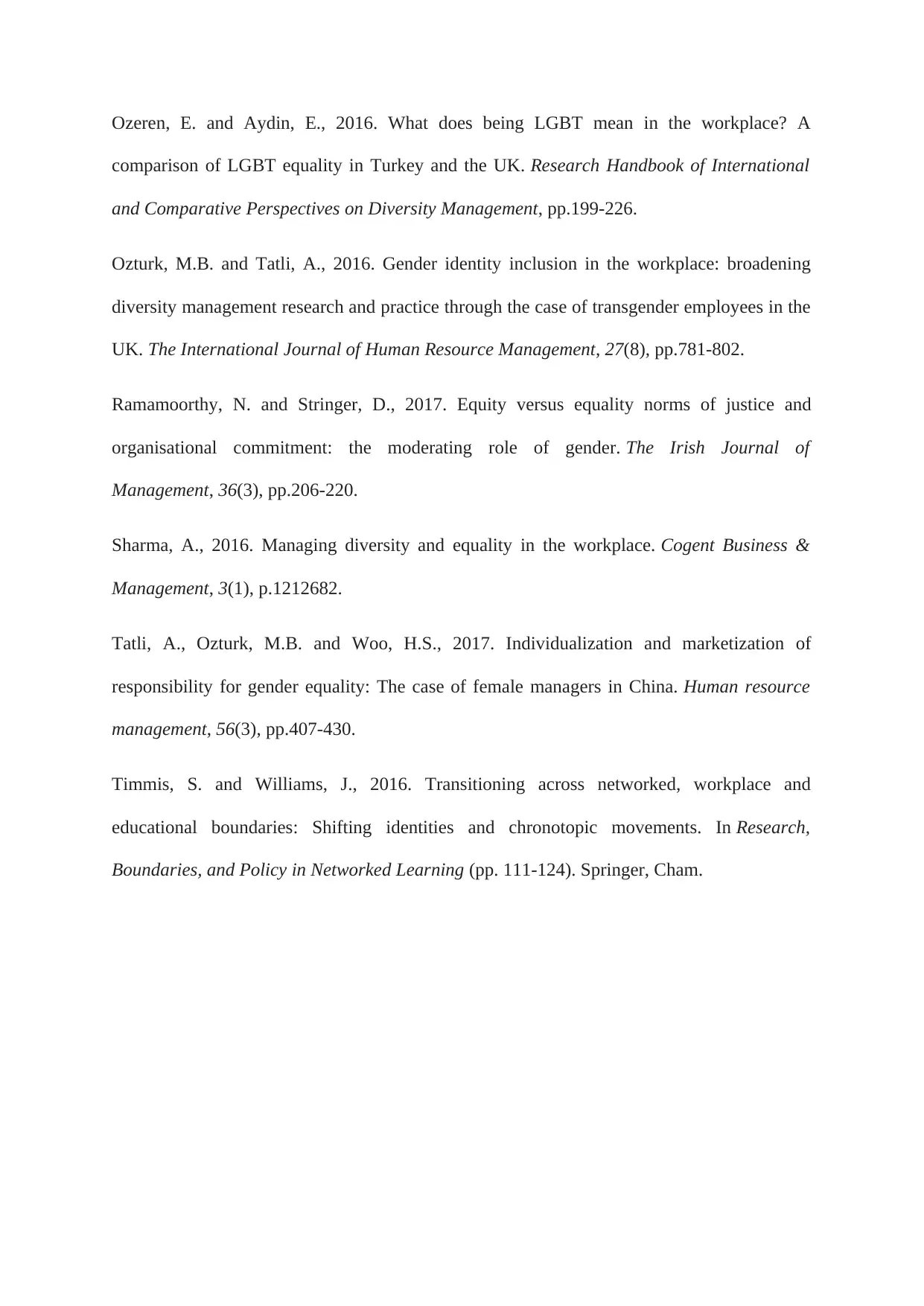
Ozeren, E. and Aydin, E., 2016. What does being LGBT mean in the workplace? A
comparison of LGBT equality in Turkey and the UK. Research Handbook of International
and Comparative Perspectives on Diversity Management, pp.199-226.
Ozturk, M.B. and Tatli, A., 2016. Gender identity inclusion in the workplace: broadening
diversity management research and practice through the case of transgender employees in the
UK. The International Journal of Human Resource Management, 27(8), pp.781-802.
Ramamoorthy, N. and Stringer, D., 2017. Equity versus equality norms of justice and
organisational commitment: the moderating role of gender. The Irish Journal of
Management, 36(3), pp.206-220.
Sharma, A., 2016. Managing diversity and equality in the workplace. Cogent Business &
Management, 3(1), p.1212682.
Tatli, A., Ozturk, M.B. and Woo, H.S., 2017. Individualization and marketization of
responsibility for gender equality: The case of female managers in China. Human resource
management, 56(3), pp.407-430.
Timmis, S. and Williams, J., 2016. Transitioning across networked, workplace and
educational boundaries: Shifting identities and chronotopic movements. In Research,
Boundaries, and Policy in Networked Learning (pp. 111-124). Springer, Cham.
comparison of LGBT equality in Turkey and the UK. Research Handbook of International
and Comparative Perspectives on Diversity Management, pp.199-226.
Ozturk, M.B. and Tatli, A., 2016. Gender identity inclusion in the workplace: broadening
diversity management research and practice through the case of transgender employees in the
UK. The International Journal of Human Resource Management, 27(8), pp.781-802.
Ramamoorthy, N. and Stringer, D., 2017. Equity versus equality norms of justice and
organisational commitment: the moderating role of gender. The Irish Journal of
Management, 36(3), pp.206-220.
Sharma, A., 2016. Managing diversity and equality in the workplace. Cogent Business &
Management, 3(1), p.1212682.
Tatli, A., Ozturk, M.B. and Woo, H.S., 2017. Individualization and marketization of
responsibility for gender equality: The case of female managers in China. Human resource
management, 56(3), pp.407-430.
Timmis, S. and Williams, J., 2016. Transitioning across networked, workplace and
educational boundaries: Shifting identities and chronotopic movements. In Research,
Boundaries, and Policy in Networked Learning (pp. 111-124). Springer, Cham.
1 out of 8
Related Documents
Your All-in-One AI-Powered Toolkit for Academic Success.
+13062052269
info@desklib.com
Available 24*7 on WhatsApp / Email
![[object Object]](/_next/static/media/star-bottom.7253800d.svg)
Unlock your academic potential
Copyright © 2020–2025 A2Z Services. All Rights Reserved. Developed and managed by ZUCOL.




